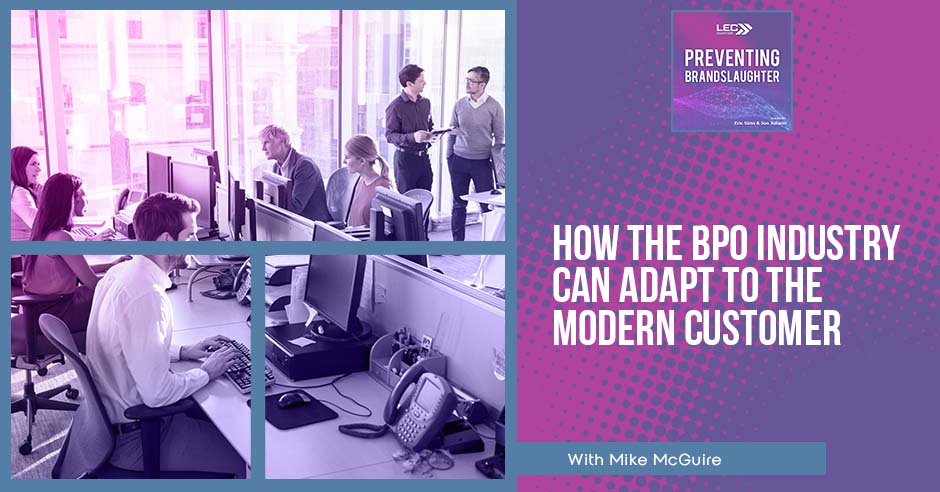
In this inaugural episode of Preventing Brandslaughter, Jon & Eric talk with Mike McGuire of NobelBiz about the ins and outs, ups and downs of navigating the BPO industry with integrity. The world has changed, and contact center businesses need to adapt to new ways of communicating with customers to remain relevant and profitable. Tune in as Mike shares the secret ingredients to NobelBiz’s approach to Preventing Brandslaughter with their own customers.
—
Watch the episode here
Listen to the podcast here
How The BPO Industry Can Adapt To The Modern Customer With Mike McGuire
Welcome to the first episode of Preventing Brandslaughter where we discuss all things brand-related, the ups, the downs, the ins, the outs, the triumphs and the disasters that take place with companies as we all try to reach, connect and build a successful brand. We’re excited about our first episode. We have invited our good friend, Mike McGuire, from NobelBiz to join us. Mike, thanks for coming to the show.
I appreciate it.
I’m very excited to have you.
I am excited to be here. I love the topic. Brand is amazing. In the contact center space, there are usually two avenues. Either you’re on the, “I don’t want anybody to know who I am,” side or you’re on the other side, which is, “We do a lot of great things. Let us tell you about it.”
As we get started, I’m going to level set the audience because since this is our first episode, there are probably a lot of people wondering, “What is brandslaughter? What does that mean?” We have coined the term brandslaughter because it’s the act of knowingly or unknowingly leveraging the wrong talent techniques and/or technology that can damage your brand or even kill your brand.
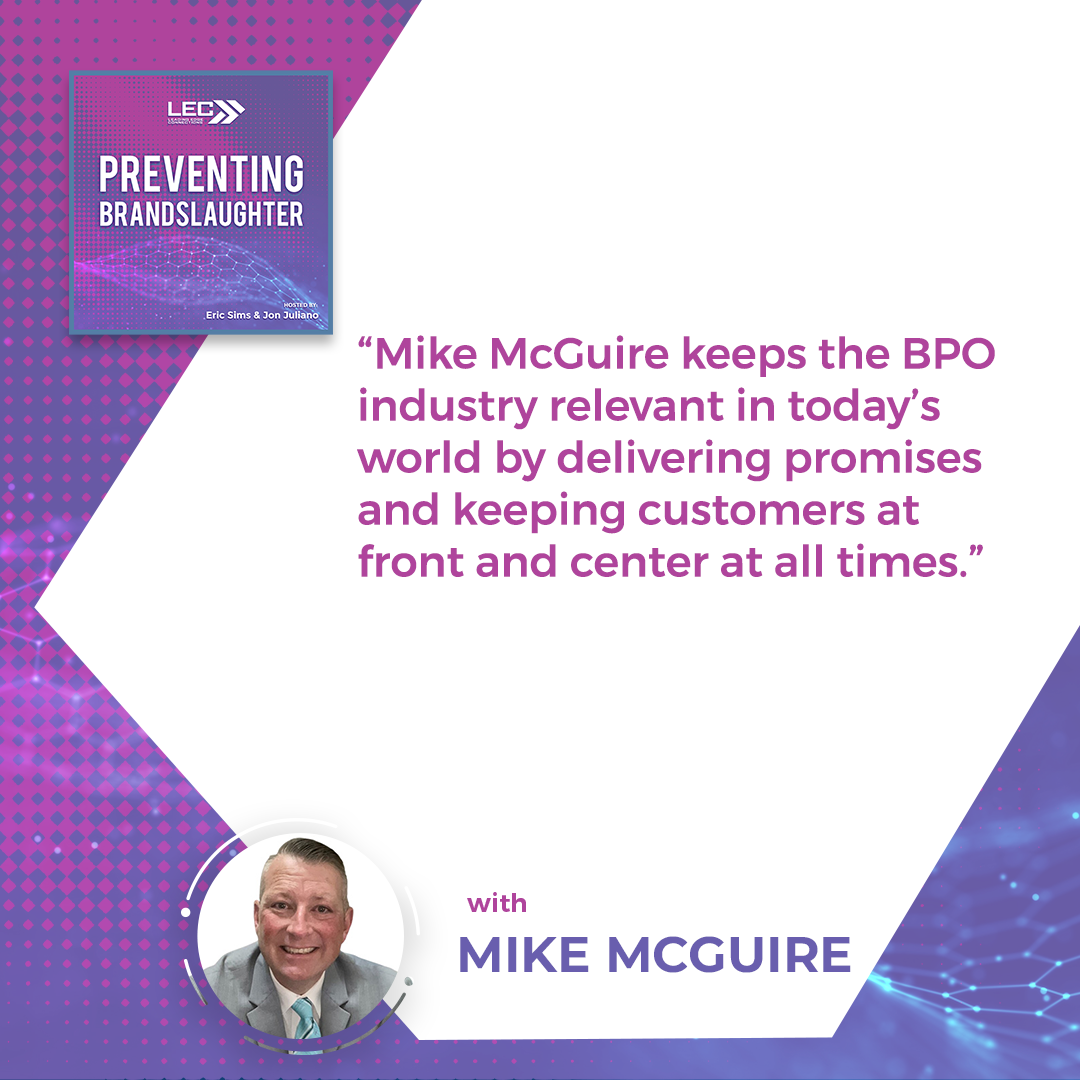
Many of us have struggled with things like that unintentionally. Most people that own businesses don’t set out to ruin their brand but we have all seen it time and time again in several different ways. We wanted to chat with you about what you do, who you are, how your brand works and some of the things that you are doing out there to help not only protect your brand but protect other brands as they go out into the market space. Maybe we can get some stories and things from you around stuff that has worked and not worked and things like that but first, let’s find out a little bit more about you. From the background right there, it looks like you’re located in California.
I’m in North Carolina but I’m a big Chiefs fan. Don’t hold that against me if you’re on the other side. I’m a call center nerd. I got my start years ago. I walked into a call center. It was a fundraising call center so it was pretty chaotic. All these guys were from New Jersey and came to a small town in Kansas where I grew up. I worked my way through that company. I was there for about eleven years. We went from 6 call centers to 75. There’s a lot of growth. I opened up about twelve different call centers throughout the US with that company and then moved around.
I did some collections. I was the president of a BPO in the lead gen mortgage space. A few years ago, I moved into technology. I’m with NobelBiz, which is a technology company. That’s where I’m at but I would consider myself somebody that went from the bottom up in the call center space through all the trials and tribulations before there was HR even when everything was outbound phone calls. That’s a little bit about me. That’s where I come from.
I’m going to pretend I don’t know anything about you. NobelBiz is a technology company. Tell the audiences a little bit about what you do in the market space, what are you offering, what type of customers you serve and things like that.
NobelBiz got its start as a carrier. It has been in business for about 24 years. What I mean by a carrier is they carry the back-end infrastructure of a lot of call centers like your VoIP, lines, T1s and all that type of stuff. They did that for a very long time for some large clients. Years ago, they decided, “We want to get into the CCaaS or the call center technology side of the business.”
A few years ago, we launched what we consider OMNI+, which is an omnichannel solution for call centers. We service all different verticals. We specialize in the BPO space because BPOs are quite unique. They will take on clients from a lot of different verticals like sales, collections, customer service and tech support. BPO services a lot of different environments. We try to create our nimble technology.
We can take a client or a customer that says, “I only need 10 or 15 seats in sales,” but then maybe they bring on a client that has 100 seats in customer service. We try to find the technology that we can partner with our BPO or our call center and have a solution that can meet a lot of different needs versus, “We’re a collection technology. We’re a sales solution.” We try to find that niche of being able to service a lot of different markets with our clients.
Here in the evolution of your career starting on the call center side, dealing with politics and collections and working your way into technology, I’m sure you have several experiences over the course of your career where you’ve witnessed some form of brandslaughter. Politics take that away. I’m sure there’s no brandslaughter in politics. You never have to deal with that. Maybe chat us up a little bit about some of the most egregious forms of brandslaughter that you’ve experienced.
I won’t name names but the companies where I got my career started with this. A lot of this was pre-social media. Without social media, these guys wouldn’t be in business. Social media changed the game when it came to brands and how quickly your reputation can get out there. I was working for a company. Based on the type of business we did, it divided the call center into male and female. Some of the type of campaigns we dialed on was more generated toward males and maybe calling for police, fires and stuff like that. Other campaigns consider more females.
Unfortunately, there was a pay gap difference. Quickly, this gets out into the world. Call centers aren’t quiet about things. You’re working in usually communities. It destroyed them to a point. Even though maybe your revenue was different based on those models and you could pay a little bit more, understanding what you were projecting out into the workforce or the community depending if you’re a male or female is going to dictate your pay.
That was a brandslaughter. That was tough. It seems like common sense but in reality, the way that they looked at it is, “This generated 30% to 40% more revenue.” We passed that on to the employees but unfortunately, the way they set it up in the optics was terrible. That’s one example where they could have done things differently and set them up differently to eliminate that bad reputation.
One of the things you pointed out there is important. That’s an exaggerated example. People may even look at some of that stuff and go, “I can’t believe that would even happen.” It sounds like we’re talking about segregation and things like that back from the ’60s, civil rights and stuff but it wasn’t that long ago. I’m not naive that there are not bad business leaders out there but I choose to believe most of these decisions are made out of ignorance. They’re not out of malice. It’s out of the fact that we never even thought that this would be a problem because we didn’t take the time to evaluate the situation and say, “What if this and that,” and get feedback as well.
What it did is it crept in. They started the business as one and then started another line of business that allowed them to grow. When they were hiring for that other line, they hired different types of people. At the end of it, you look back and say, “How did I let that happen?” It wasn’t like they purposely even set it up that way. It was like, “We have a new line of business. We’re able to hire more people and grow. This type of person did better on this,” but ultimately you have to guard that type of stuff for sure.
You’re a victim of your success. You turn something that’s a triumph into a tragedy within your brand based on a mistake of not evaluating or looking at things a little bit differently. That’s a good example. You are unique because you’re industry agnostic and then you touch a lot of different types of businesses and entities out there. Most of those are taking on several different types of interactions. By interaction, I mean calls, emails, text messages social media and things like that. There’s a massive amount of communication going on. What are you seeing in our market space that looks to be one of the biggest challenges to protecting a brand out there? If you’ve got a brand that’s doing it well, give us an example. You can’t drop names but maybe give an example of that.
Our motto is promise-keeping. It’s something that we have been built on. It’s something that the president Steve Bederman has always made a point to. Everything revolves around promise-keeping. In this industry, it’s rare because I’ve bought into technology before in the call center space. I’ve been out shopping for stuff. A lot of times, in this space, people overpromise and underdeliver, meaning, “You can do this.”
I never experienced that.
Especially when you’re in sales and somebody is like, “Will it do this? Can it do that? Can you do this?” Your answer is yes. In your mind, you’re saying, “Technically, it could do that but is it a reality that it’s the way the system is built?” The biggest thing that I try to keep at the forward front of my conversations at NobelBiz is the reality of your business and this relationship. If it doesn’t make sense, you’re going to respect me more for saying, “I don’t think it’s a good fit. We could do this but it’s six months down the road,” and preserving that promise-keeping relationship and that brand versus, “All I have to do is get them to say yes. All I want to do is get them to sign. Let’s figure it out down the road.”
That’s one thing that I have found on the NobelBiz side that is a little different in this space, especially in the technology to call center space. Clients or customers and technology companies are almost going down a different path to where it is a true partnership. It’s not as transactional because you as a BPO might not know what business you’re in next year. You may have a client that says, “We need customer service.” You’re like, “Can we do this? Is this technology in this position where we can do this?”
That partner relationship and that communication have to be much more open and honest to preserve the brand because we can all overpromise. I could sign and then you fire me in a month but every time that you do that, you’re destroying your brand. Even though we think call centers are huge, we all know some of the same people and we didn’t even come from the same companies. Once that bad name or brand gets out there, it takes a lot more to recover that brand than it did to herd it.
From your seat as a potential customer, what should I be on the lookout for if I’m talking to ten different companies in terms of, “Am I being led down the path of potentially experiencing brandslaughter? Am I dealing with somebody open, honest and transparent with all things?”
I always say, “The devil is in the details.” You’ve been in the game long enough that you understand where the got-yous are, especially if you’re looking for technology. If somebody is like, “Everything is included,” that’s usually up to a certain point or, “You can integrate anything.” It’s always in the details. I always look for the people that shoot me straight and don’t have a problem with telling me, “We don’t do that. That’s not what we do but if that’s something you want to do, let’s explore it together.”
“There are solutions that we have or we don’t have that you may need but if it’s a case where this is important, let’s figure it out together. Let’s figure out how we can make that integration,” versus, “We can do that.” You sign the client and then you’re like, “Let’s go.” I’m like, “We could do that in six months. We could do that for $10,000.” It’s the details of the business that we know.
If you’re in outbound calling, you know there’s going to be a telco involved. There are going to be VoIP charges. There could be DID charges. If you’re buying a seat, what’s included? Is it inbound and outbound? Is there an upcharge for SMS, emails and social media? Those details are important. Testing that relationship by asking those questions will let you know pretty quickly the type of company that you’re involved with.
You bring up an interesting point. You have a promise keeper’s mentality, theme or core values type thing at your organization. That’s a big deal, whether that’s you, other people within your organization or your competitors that are out there. You elaborated a little bit about how the end of that game looks with people overpromising, underdelivering or being able to communicate effectively. Those are great examples of brandslaughter and brand protection.
By setting proper expectations with people and being informative and transparent, you don’t have clients and customers that are unnecessarily frustrated on the back end, which is damage to the NobelBiz brand. They may even be out damaging their brand because they’re overpromising and underdelivering there based on what they thought you were able to do. As NobelBiz, how does your internal team support the culture of that? Do you have specific training? Is it embedded in everything that you do from a content standpoint? Can you talk to us a little bit about how you keep that?
When I first started at NobelBiz, I was the Guinea pig on the technology sales side. What they said is, “We want to look for people that have contact center high-level experience to talk to our customers versus somebody that sold technology before.” We have continued that path. Now that I run the team, I’ve hired two other people that come specifically from running call centers. They have experience with utilizing technology or buying technology at different levels.
That level of experience in this case allows you or the client to be able to talk to people that are knowledgeable about their business. They have managed turnover and callers. They have had to meet P&L responsibilities. The biggest thing is they understand the urgency that’s in a call center when the dialer goes down. People don’t understand the little things.
That’s an example. On this side of the team, we said, “If we want to be promise keepers in this space, then we need to have people that understand our customers at a more intimate level than somebody that sold them a transactional technology.” That’s one example. We purposely put a layer into our operations to have client advocates for all our customers, meaning our customers have a resource to go to that is more involved with their voice of the customer than they are with the inner workings of our business. This client advocate has a say over everybody else on what the customer needs.
A client advocate must have a say over everybody else on what the customer needs. Share on XA good example would be this. You go to your client advocate and you’re like, “I need this report next week. This is a big issue. We have to have it and so forth.” That client advocate doesn’t look at it and say, “What’s that going to cost? How much time is involved?” Their job is to service the client and make it happen. Let everybody else worry about the whats, the ifs and the ands.
Before, that was a sales guy. The sales guy followed that process from womb to tomb. This client advocate is purposely placed here to say, “If we want to be promise keepers, we need to have an advocate for every one of our clients that is the spokesperson in that environment.” You’ve had account executives and stuff like that but how Steve put that in to have that client advocate helps foster the whole promise-keeping from sales all the way to the end.
I like the fact that you have started with the customer and then reverse-engineered what support and sales structure needs to go in place based on the customer, not based on the product or service. That’s a big mistake a lot of people make out there that’s unintentional. They do it the other way around, “Here’s my product. Here’s my service. How do I want to sell it? I’ll talk to the customer based on that,” versus, “Who is my customer? What do they need? How do I find people that understand that world from the get-go?”
The BPO industry is an exaggerated example because it’s so dynamic, which makes it even harder for you, which is even more impressive to me that you’ve been able to do it that way. It’s not such a one-dimensional business as others are. It speaks highly of how that is successful and can be successful for other brands out there. Jon, I had a question for you on that. We work with a lot of clients out there that are diverse. We’re in the BPO space. Do you see a similar thing or struggle with similar clients we have either entertained or serviced even around that?
It’s the majority of people that we engage with daily. In the first conversation, we talk about their customer journey, “Walk us through the map.” The map is usually laid out the way that you stated, which is, “We have this product. We have this service offering. Here’s our go-to-market strategy. Here’s the customer acquisition point. Here’s where they drop into the funnel.”
They lay out all of the steps instead of looking at the customer journey as an end piece and saying, “How can we enhance the overall journey? How can we make it more customer-centric as opposed to being product or service-centric?” That’s something we emphasize and spend a lot of time in the discovery process to say, “If you want to keep the customer, you have to understand the customer. That’s their habits, trends, wants, needs and desires.” You can fit your product or service around the customer as opposed to the other way around.
It changes your whole communication track. To your point, your team has been built around the employee experience as well. I’m positioning people to be in their most powerful space because there’s familiarity with a certain aspect. Maybe I’m teaching them some stuff about our technology but I’m taking this wealth of experience they have had in other industries and businesses and letting them use that powerful point for them. I would assume that cuts down on errors, times to competency for your sales team, effectiveness for them and improved customer experience for your customers.
What I learned early on is most people in this space that is looking for technology usually reach out to a consultant. That’s the avenue they buy, 70%. What I said is, “Why are they reaching out to a consultant?” They know their business a little better probably than the consultant knows their business. It’s that familiar, “What’s out there? What could I not be using? What don’t I know,” type of mentality.
I’ve tried to use some of that in the direct sales model. If I can work with a customer and understand what is their vision, what are they trying to offer, how I would have done it or how I’ve done it in the past, then maybe I can lend a much better resource of how our technology can or can’t fit in what they’re trying to accomplish versus always putting a round peg in a square hole.
It’s one of those types of things. In this space, people have always tried to make it up as you go versus having experience, “When I used to do this, I ran into X, Y and Z problems. How can I help you not even go down that path?” Those are some of the types of experiences that we try to give our customers out of the get-go. Everybody has different resources. I could have a customer that’s got five IT guys sitting on the side waiting and all these different resources. I have a customer that it’s him and his partner. We have to treat each one of those very differently.
I can’t say, “If you don’t have the resources, then we can’t do business.” I could but that limits you. I could say, “We’re going to have to build scripts and work hand in hand with this customer much more than we are with these guys because these guys are going to want access.” As somebody that understands that and wants to be a company that can service both sides, then you have to have a different skillset and experience with each one of those people.
I would like to get a little more specific while we have time around NobelBiz some of their servicing and some specific things around some of the stuff that you’re doing from a technology standpoint and how that’s helping other brands protect themselves against brandslaughter, maybe specifically around some of the outbound things that you have come up with from technology side. That world has changed a lot. Back when we all started, it was like, “Hit the autodialer.” It dialed nine million people.
There may have been cell phones at that point but there probably weren’t. We would call it house phones. That game has changed. There’s a lot of stuff that has been put into place that is trying to help the consumer. It’s consumer-protected and related but if brands aren’t approaching that properly, they are unknowingly destroying themselves on their typical outreach. Talk us up a little bit about what NobelBiz is doing to help with that.
They could destroy themselves in multiple ways. They could financially ruin themselves with some of the laws and regulations, TCPA and some of those things that are out there as a government entity now that is regulating businesses. In the outbound space, usually, there are a couple of different veins. You brought up cell phones and the way you dial. That’s changing. As consumers move toward digital and start looking at SMS, emails social media and ways to communicate, it’s important for technology to also adapt to those new ways of contacting people.
As consumers move toward digital communication, like email and social media, technology must adapt to those new ways of contacting people. Share on XIn the outbound space, some of the important things are, “Are you following the law? If you’re calling somebody, do you have express written consent? Do you have permission to contact them on a dialer?” If you don’t, we have technology that you can utilize where you can still reach out to those people but it’s compliant. It’s not a full predictive dialer but it’s a lot more productive than doing a manual call. Some technology lies in there that gives you some protection but it also gives you the ability to hit the numbers that you need to pay your people.
There’s that space. The other space is around number management. Maybe people don’t know but when you’re reaching out to people, the carriers are regulating some of that volume by either labeling calls as spam or scams in other ways. We offer technology that allows you to register your DIDs and be transparent. This is who we are if you want to put your company’s name on there and so forth. We have technology that allows you as a customer to be able to display those DID and diversify them so you’re not showing the same number over and over again as you reach out to people.
On the technology side, what I see changing is the days of loading up a list, dialing people 5 to 6 to 7 times a day, expecting that they’re going to pick up and be happy about that. It’s changing. When you reach out to people, there is a strategy. Why not make a call? Why not leave a voicemail? Why not send an SMS and an email all at the same time?
You’ve touched this person one time. You’ve done three touches on this one attempt that allows that person to even call you back. Utilize those other channels. In the end, you’re looking at the customers saying, “Maybe you communicate via text or email a lot more than you do phone calls.” I’m one of those people. Eric, if you text me, I’m right there. If you call me, it’s probably going to voicemail. At least I’ll call you back but we’re all on Zoom calls and stuff all day.
On the technology side, as you alluded to, what is the customer’s preference? How do you adapt your call style or communication style to that person, which is going to cost you, in the long run, less money? You’re not dialing them over and over again. The customer is going to be more responsive. They’re more likely to call you versus you calling them ten times. There are those types of technology that we have invested in, especially in the outbound space. We try to partner with our clients to figure out the best strategy to get ahold of these people.
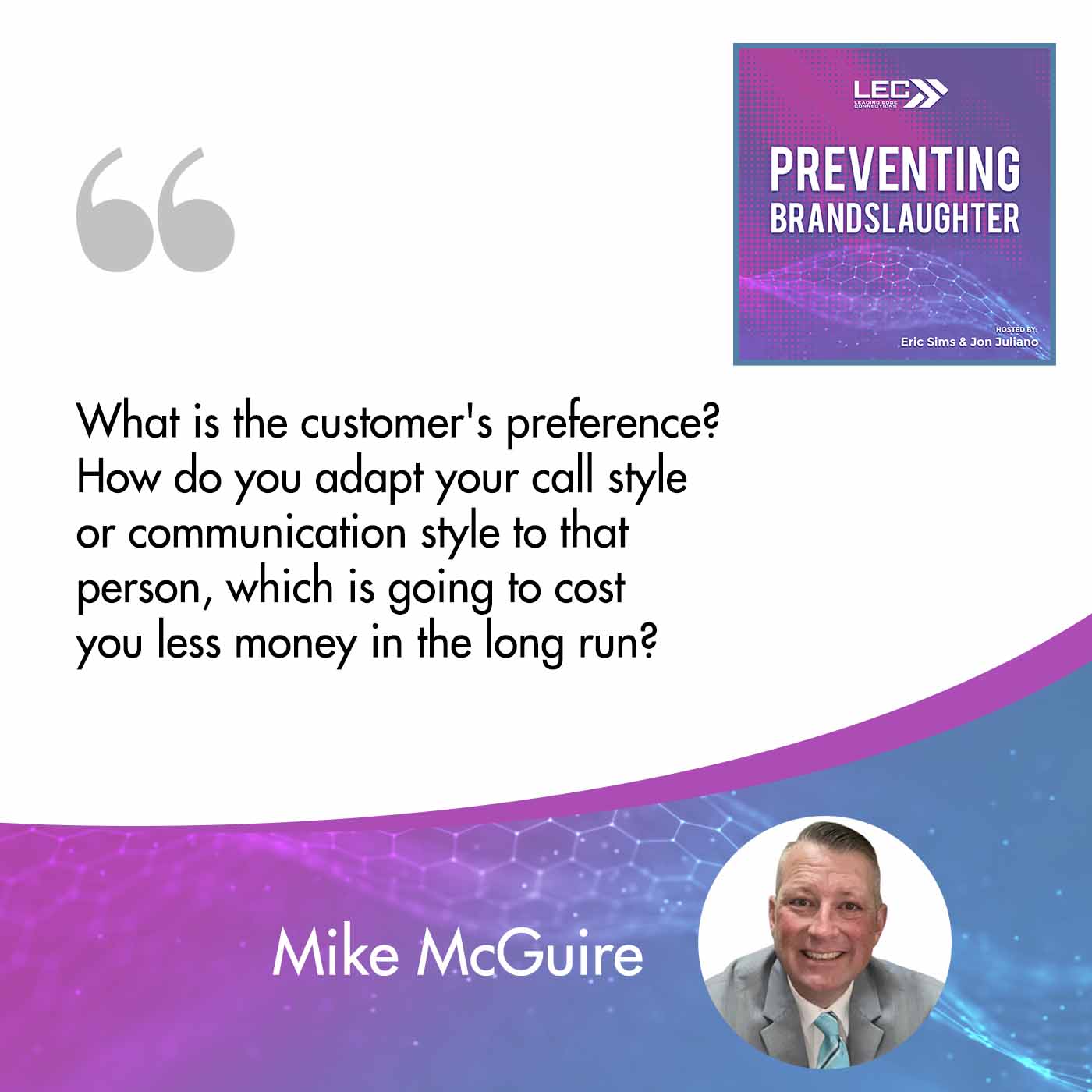
The cool part there is you’re still chiming in on the fact that you brought up that the customer has a preference. Being able to figure out, understand or offer that preference, not forcing them into a certain lane and also being compliant is a big piece. It’s being able to communicate. When you look at the studies that are out there about generational preferences or when you look at Millennials, Gen X-ers, Baby Boomers, Gen Z or whatever the rest of them are, they all have different preferences. You brought up even the caller ID display showing who you are.
I’m a leader of an organization. I’m almost in my 50s. I have to realize that what once worked and was successful when I did stuff years ago and what was successful when Jon was doing it doesn’t necessarily mean it’s going to be successful now. I’ve got to continue to take the time to understand the customer and their preferences so that I can communicate and connect with them the way they prefer to be connected to. It’s a different one. If you looked at what we used to do and asked me, “Should we have a caller ID on an outbound call that identifies the company to the caller,” we would all say no in the past but in the new studies with the Millennials, guess what the answer is.
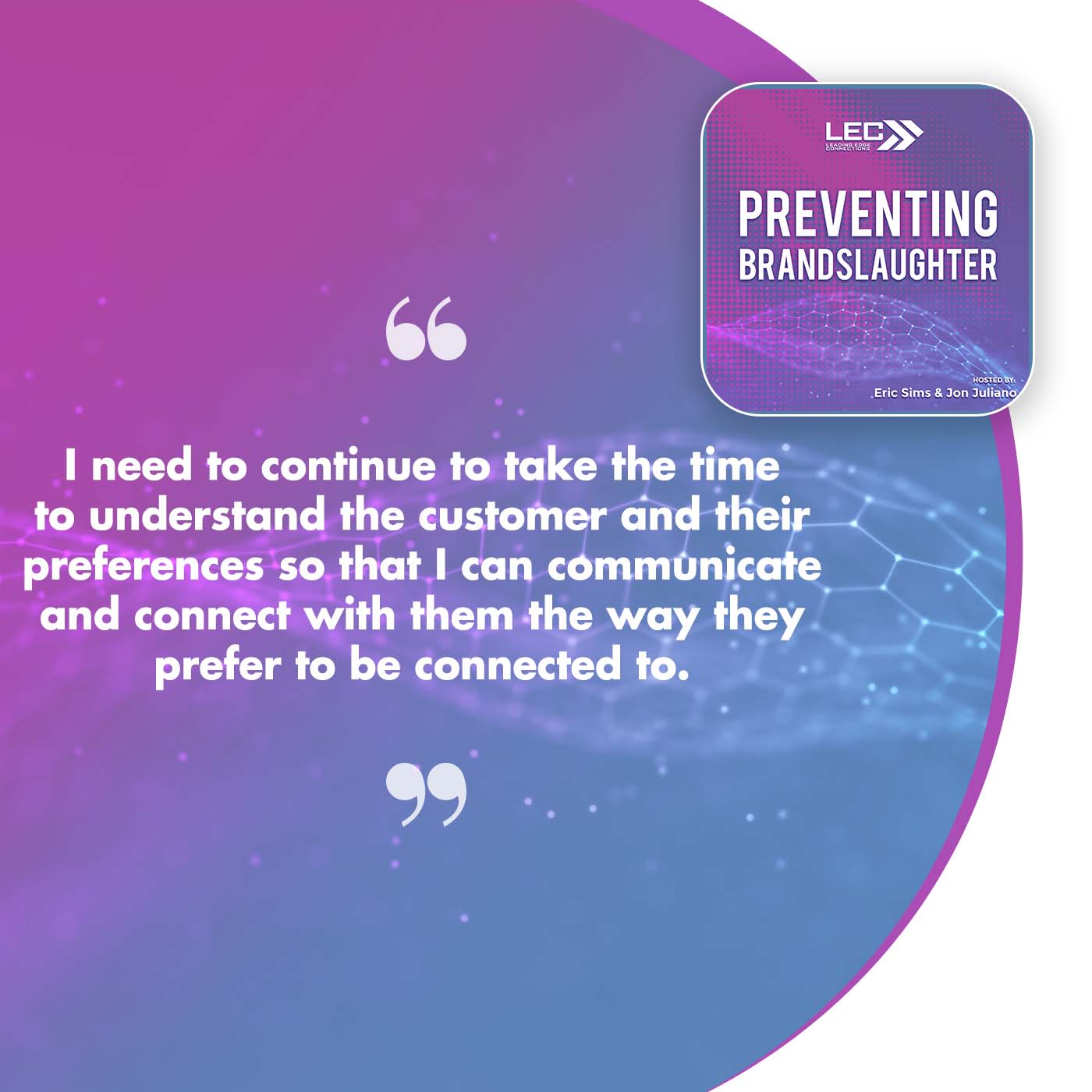
They won’t answer a call unless they know who it is. They prefer not to get phone calls unless they know who it is or at least it’s showing them who it is. It does change the game. They still prefer text messages and emails over phone calls anyway. Those are the things that you go back to and say, “If I’m understanding my customer and continuing to put those efforts in to understand my customer, I have to be highly nimble, flexible and evolutionary to continue to do that.” You are doing some great stuff with that when you’re looking at your servicing and technology. I don’t know if you have anything to add to that, Jon but it’s a good point.
Your industry alone is very challenging because you don’t have to understand your customer but you have to understand your customer’s customer. There’s a lot to peel back there. My question is this. How do you do that? How do you champion that initiative to get inside the business that you’re working with to understand their client base and their client’s client base?
My experience has helped me a lot by doing so much and always being a student of the game, meaning I’m at these shows and events. I know what new technology is out there. I talk to hundreds of people every week. I was in Vegas for the Affiliate Summit and then I hopped on a plane to a fundraising event in Florida. They’re two different industries but I have experience in both. None of that matters if I’m not a student and I’m not trying to learn, develop, come up with new strategies and talk to customers about their complaints and issues and why business is ineffective.
That’s one level. I try to continue to be on that cutting edge or the leading edge of things. I try to continually be a student of the game. The other thing is you have to take the time to learn about your customer and your customer’s customer. If I’m going to work with somebody, the first thing I do, especially if they’re a business, is call their customer service line, go through their prompts and then talk to their agent. When I have a discovery call with them, I’ll say, “How does this work out?”
Usually, 9 times out of 10, I already know a lot about their business what’s good, bad or indifferent. I can quickly be able to say, “This is my advice. This is what I would do.” At the end of the day, you nailed it when you said, “Go from the customer’s experience and work your way back.” Here’s a good example of brandslaughter in my mind. We will see how it plays out. Some airlines are cutting off their call center. The only way you’re going to communicate is via text or chat.
I don’t know about you but whenever I call an IVR, I’m usually going, “Supervisor,” or I’m hitting one and trying to get past that IVR. Imagine I’m in Mobile, Alabama. I’m stuck on a flight that has been delayed and I need to do another flight. I’m sitting there on my phone and chatting with a chatbot. That’s not going to play out well. I am not going to book my next flight with that company.
When you look at brandslaughter, you have to look at that customer end. For the airlines, we all fly. We all understand that. The last thing we would want to do is eliminate a human connection because a lot of times, we want to vent, “How dare you cancel my flight? How are you going to pay for my hotel?” That’s where humans can show compassion. They can talk you off the ledge, give you something free and then preserve that brand and relationship. When you don’t have that, I can’t see that playing out well.
Without revealing the company name, I’m sure everybody knows who this company is because it has been all over social media, TV, radio or wherever you want to put it. That right there is the exact definition of brandslaughter. It doesn’t take a lot for your brand to go from up top to the basement. It’s just one simple decision that affects the whole outcome of your customer journey.
I don’t think companies look at it at the moment. After a while, they reflect on it and say, “That was a bad decision,” but at what point is it not salvageable? At what point do your customers find an alternative and never come back? All of us that work in a brand or have a brand that we’re leading have to be hypersensitive to that when we’re making these decisions. They can’t always be financial. Most of the time when you’re leading a business, you’re trying to make a decision about your employees and the people that rely on you every day but the other thing that has to be in your mind is if you’re thinking about your employees, you should be thinking about your brand. That’s what’s paying those guys.
They are the brand. They’re the ambassadors that are out on the front for anybody. The airline industry is getting pummeled because we’ve got a lot of storms going through Texas. My flights got canceled. What they’re struggling with is something for older organizations. Jon and I don’t see this a lot when we work with startups and brand-new companies that may become clients. They have different challenges.
All three of us have worked for companies like this where they typically have the flag of, “This is the way we have always done it. This is the way we do it.” They get married to certain models or structures. To your point, Michael, you can’t make all financial decisions but at the same time, finances bleed into everything. It does come to a point where we have to make some financial decisions.
We have all seen these waves before. In some markets, there’s a lot of onshore work. In some markets, there’s a lot of offshore work. We will stay out of the political conversation as to who drives what, when and where but I know that the three of us are in agreement. What happens is people put a priority on that dollar. You’ve got to start weighing out, “How much am I willing to damage the brand to meet the financial need?” It is a tricky game, especially in our industry and any other business out there that says, “We have to save money.”
The problem I see with a lot of companies is they try to keep working within the old model and play that game versus saying, “Technology is moving at a massively fast pace since the last time we had to evaluate this. Maybe there’s another way to do what we need to do and keep quality, lower some costs and make it more efficient. That doesn’t damage the customer experience.”
The problem with a lot of companies is they try to keep working with old models instead of embracing new technologies. Share on XWe all live in that world. We immediately pick up the phone. We’re calling airlines, “We could fix this in fifteen minutes.” It wouldn’t be the no-one-is-answering-the-phone option or you’re getting a guy in India who can’t speak English at all and frustrating your customers that way. There’s nothing against Indian people or call centers in India. They’re great at certain things and there are certain things that they’re not great at like any of us.
That’s an important point that you see with these guys. Take a step back, put the customer first and then reverse-engineer, “How do we create a solution that’s in our budget and keeps our margins where we need them or our money where we need it but still solves the customer issue in a way that is going to keep them with us?” At the end of the day, if I save $5 but lose $4,000 with that customer over the next year, that is a bad financial decision.
To your point, a lot of people get shortsighted with how they want to fix the problem. They fix the problem financially now but they cause a financial loss over the course of 2 months, 10 months or 12 months. I’m going to fly numerous times in the year. You might have saved $0.50 but you lost a customer that’s going to spend $5,000, $10,000 or $100,000 a year, which made a major difference in your financial model.
From what I’ve experienced in the past few years of doing this, most big companies look at customer experience or customer service as a cost center. We can all agree. If you take a deep dive and look at customer service as a whole, it’s one of your largest profit centers or could be. In sales, you have to bring a new customer in. You get them to make a purchase. You don’t know if they’re going to stay. In customer service, you’re retaining those customers and keeping your core business there.
That’s where a lot of businesses disregard it and say, “What’s the cheapest option? What can we do to maybe get an answering service or eliminate the call center entirely?” What businesses need to do, especially the older businesses, is they need to say, “Back in the ’80s, what were the personas of the individuals buying my service or my product? Are they the same now as they were back then?” I can answer the question for you. It’s a no. Why are we doing the same stuff that we did years ago? That’s the question I need the answer to.
For some people, it’s too big to fail. Some brands look at it as, “We’re too big to fail,” but for everybody that tells me that, I look at Sears and some of these other brands that quite honestly used to dominate the market space. They knew what their customer wanted back then but they failed to create, develop or change for the market now. The other different thing is companies make a lot of assumptions based on the brand, meaning people would rather have a cheaper price than a better service. That model is tipping a little bit where people are like, “I’m okay to pay a little bit more if I can get my service taken care of.”
“If I can get what I want, I’ll pay for it.” The statistics show that. I said something about that earlier. The leaders of today that I see that are super successful and the average age of a CEO has dramatically changed are far more open-minded to new ways of doing business and operating than the traditional older CEOs. I’m not doing this as an age thing. You get married to success. You’ve had success. We did it this way and it worked. It’s hard to say, “If we keep doing it this way, it’s not going to work.”
“How would that happen? We have already done it that way and it worked.” The reality is you’re not taking what Jon said into your calculation, which is the consumer has changed, which does change your whole formula. You’ve got to continually change your formula to meet the consumer’s demand. If you’re not building it from that stance, you’re eventually going to be like Sears. It will happen at some point.
Look at the space we’re in. Let’s look at the call center space, the technology and how we run our business now versus what we did years ago. The typical call center years ago was a big building with a lot of people with T1s in the building and a bunch of people in the call center. You hired as many as you can, turned through them, found a core group, and kept turning through them. Everybody is in agreeance with that. That’s how it was when we all came up.
All of a sudden, technology changes a little bit and says, “We have cloud technology that could allow you to have multiple centers in multiple areas but now you can even have agents in all different centers on the same campaign.” You’re like, “If I’m calling New York, I can have a center that has people that are more Eastern New York to call these people.” That worked well. We said, “That’s good technology.” All of a sudden, we said, “People like to work from home. They don’t want to get in their car and go for an hour of commute. They would rather sit in their house and work from home because this job and technology can allow that.”
Look at where we’re at. If the industry wouldn’t evolve, COVID would have wiped everybody out. If technology wasn’t at the point where it was during COVID when people started expanding and looking at at-home agents and all that type of stuff, then it would have stopped. It would have been a bigger disaster than what it was but we’re looking at the end customer and the end customer doesn’t care where you’re calling from. If you’re happier because you’re at home and you give a better experience to that person because now you don’t have to go through an hour commute, then the customer is in a better position than this guy that’s sitting next to a stinky person and that yells at him.
The end-customer does not care where you’re calling from as long as he gets a good experience. Share on XIt goes back to some things that Jon and I implemented when we started Leading Edge as a remote company. One of those things was you can’t ask someone to impart something to someone else that has not been imparted to them. Many industries were guilty of that for a long time. We expected frontline employees to be able to go out and create amazing customer experiences even though their employee experience was garbage.
We think back in our heads going, “I don’t understand why they can’t create a great experience.” Their environment sucks. Their management of them is almost like slave labor or awful. It’s a dictatorship in many businesses. You want them to turn around and treat people great. What type of person has that skillset over time to take that type of beating from an ecosystem and then turn around and recreate an entirely new environment at scale? Maybe there are 1 or 2 but the reality is it’s not very many.
The companies that are going to be most successful over the next couple of years are going to do two things. One is what we have been talking about, which is looking at the customer and figuring out what the customer wants. The second step is looking at their employee and figuring out what their employee wants. If they can create that, then the employee can go out and create what the customer needs because if they’re not getting it, they won’t. That’s a step that gets skipped.
We’re running out of time. I don’t want to get into it. We could probably do a whole other show on employee experience and user experience because a lot of stuff you deal with too is user experience. How friendly is the technology? How easy is it to use? This has been great. We appreciate you coming on the show and being our first guest. What we have all talked about is exciting and entertaining to some people out there. I’m sure we will have you back on at some point. Jon, did you have anything else you wanted to add?
Mike, where can our audience find you?
I’m all over LinkedIn. I try to post all the time. You can reach out to me at Michael.McGuire@NobelBiz.com or on LinkedIn. I would love to talk with you even if it’s talking to you about call centers and new ideas. What are the new trends? What should I be thinking of that I’m not thinking of? That type of stuff is what I do every day.
If you want to talk to Mike, reach out to Mike, you can find him under NobelBiz or on LinkedIn under Michael McGuire. Reach out to him. He can be your best friend in that industry as he is ours. We appreciate you reading the show. If you would like more information on how to prevent brandslaughter in your business, sign up for our mailing. We will look for you in the next episode. Thanks for reading.
Important Links
- NobelBiz
- OMNI+
- LinkedIn – Michael McGuire
- Michael.McGuire@NobelBiz.com
About Mike McGuire
 With over 20 years of experience running contact centers and currently Senior Contact Center Software Consultant at NobelBiz, Mike is highly skilled in analysis, staff management, and building and leading teams to meet and exceed service-level demands.
With over 20 years of experience running contact centers and currently Senior Contact Center Software Consultant at NobelBiz, Mike is highly skilled in analysis, staff management, and building and leading teams to meet and exceed service-level demands.
Michael has been in the call center world for more than 24 years running global operations for both outsourcing and internal companies. He had the opportunity to work in multiple verticals, from Lead generation, Fundraising, Collections, Telecom, Travel, etc., building strong expertise and a deep understanding of the challenges contact centers face.
Mike spearheaded the opening of 5 new call centers internationally and supervised 10 call centers as a Center/Regional Manager. He also assisted hundreds of clients in expanding their business from 1-2 representatives to over 1,000.

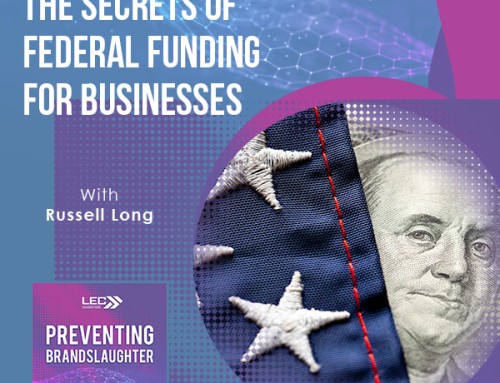
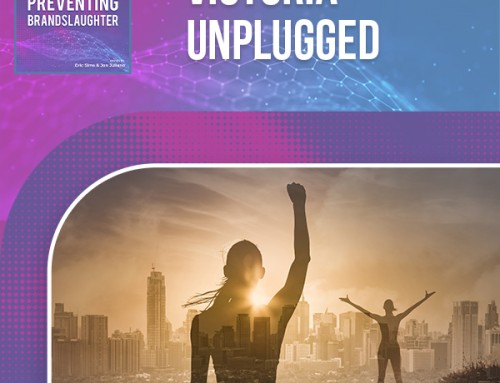
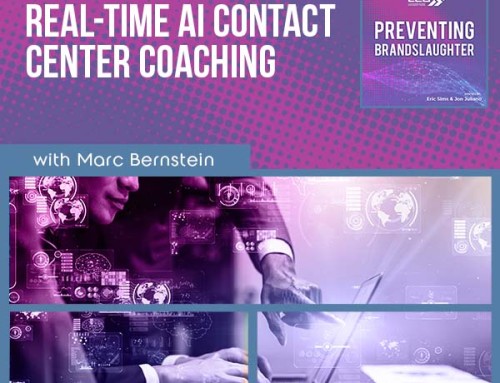
Leave A Comment